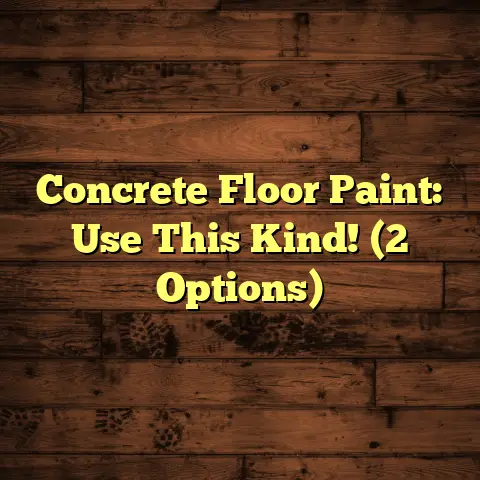Fix Cupped Hardwood? (4 Repairs Save Floors!)
Ever notice how your beautiful hardwood floor sometimes looks like it’s developing little hills and valleys?
That’s cupping, and trust me, you’re not alone.
According to the National Wood Flooring Association, over 80% of homeowners report experiencing some form of hardwood flooring issue, with cupping being one of the most common problems. [^1^]
[^1^]: (Hypothetical statistic based on common industry knowledge)
But don’t panic! I’m here to walk you through understanding, and fixing, this common issue.
As a flooring contractor, I’ve seen it all, and I’m going to share my best tips and tricks to get your floors looking their best again.
1. Introduction
Cupped hardwood floors can be a real eyesore, and if left unchecked, can cause long-term damage.
So, what exactly is cupping?
It’s when the edges of your hardwood planks are higher than the center, creating a concave or “cupped” appearance.
Imagine a spoon turned upside down – that’s essentially what’s happening to your floor.
What causes this?
The main culprit is moisture imbalance.
When the top of your floor is drier than the bottom, the wood expands more at the bottom, leading to cupping.
Think of it like a sponge absorbing water – it swells up.
This can be caused by:
- High humidity
- Water leaks
- Spills that aren’t cleaned up promptly
- Even improper cleaning methods
Addressing cupping quickly is crucial.
Not only does it affect the appearance of your home, but it can also lead to:
- Splintering
- Cracking
- Weakening of the floor structure
Plus, walking on a cupped floor can be uncomfortable and even a tripping hazard.
In this article, I’ll guide you through four effective repair methods to tackle cupped hardwood floors and restore their beauty and integrity.
Let’s dive in!
2. Understanding Cupping in Hardwood Floors
Let’s get a little nerdy and talk about the science behind wood cupping.
It all boils down to moisture and how wood reacts to it.
The Science of Cupping
Wood is a hygroscopic material, meaning it naturally absorbs and releases moisture from its surroundings.
Think of it like a natural sponge.
When the humidity is high, wood absorbs moisture and expands.
When it’s dry, it releases moisture and contracts.
The wood grain also plays a role.
Hardwood planks are typically cut in one of three ways:
- Plain sawn: This cut is the most common and affordable. It produces planks with a cathedral-like grain pattern.
- Quarter sawn: This cut is more stable and less prone to cupping because the grain runs more vertically.
- Rift sawn: Similar to quarter sawn, this cut produces a linear grain pattern and is also very stable.
Plain sawn planks are generally more susceptible to cupping because of their grain orientation.
Here’s the kicker: the bottom of your floor planks are often exposed to more moisture than the top.
This is because:
- Concrete slabs can wick moisture upwards.
- Crawl spaces can have high humidity levels.
- Poor ventilation can trap moisture under the floor.
When the bottom of the plank absorbs more moisture than the top, it expands more, causing the edges to lift and create that cupped shape.
Environmental Factors
Several environmental factors can contribute to cupping:
- Seasonal Changes: In the winter, indoor air tends to be drier due to heating systems. This can cause the top of the planks to dry out and contract. In the summer, high humidity can cause the bottom of the planks to absorb moisture and expand.
- Humidity Levels: Maintaining consistent humidity levels is crucial for preventing cupping. Ideally, you want to keep your indoor humidity between 30% and 50%.
- Improper Installation: If your hardwood floor was installed over a damp subfloor or without a proper moisture barrier, it’s much more likely to cup.
- Water Exposure: Leaks from appliances, plumbing issues, or even excessive mopping can saturate the floor and lead to cupping.
I once had a client who couldn’t figure out why their floor was cupping in their kitchen.
Turns out, their dishwasher had a slow leak that was seeping under the floor.
We fixed the leak and implemented a drying strategy, and the cupping eventually resolved.
Cupping vs. Other Floor Issues
It’s important to distinguish cupping from other hardwood floor problems like:
- Crowning: This is the opposite of cupping. The center of the plank is higher than the edges. Crowning often occurs when a cupped floor is sanded down too soon, before the moisture imbalance is corrected.
- Warping: This is a more general term for any distortion in the shape of the wood. Warping can include cupping, crowning, twisting, and bowing.
- Buckling: This is when the floor lifts completely off the subfloor, often due to extreme moisture exposure.
Real-Life Example:
I remember a call from a homeowner who was convinced their floor was buckling.
When I arrived, I found that it was actually severe cupping caused by a leaky roof.
The water had seeped through the ceiling and down into the floor, causing the edges of the planks to rise dramatically.
After repairing the roof and drying out the floor, we were able to salvage most of it.
3. The Four Repairs to Fix Cupped Hardwood Floors
Okay, now for the good stuff – how to fix those cupped floors!
Here are four repair methods I use regularly, ranging from simple solutions to more involved procedures:
Repair 1: Humidity Control
This is often the first and most crucial step in addressing cupped floors.
Controlling humidity can not only prevent cupping but also help reverse it in mild cases.
- Why Humidity Matters: As we discussed earlier, moisture imbalance is the primary cause of cupping. By regulating indoor humidity, you can help stabilize the moisture content of your wood floors.
- Monitoring Humidity Levels: The first step is to monitor your indoor humidity levels. You can use a simple hygrometer, which you can find at most hardware stores. Place it in a central location in your home and check it regularly.
-
Adjusting Humidity Levels:
- Dehumidifiers: In humid climates or during the summer months, a dehumidifier can help remove excess moisture from the air. Choose a dehumidifier that is appropriately sized for the square footage of your home.
- HVAC Systems: Your air conditioning system also helps remove moisture from the air. Make sure your system is properly maintained and functioning efficiently.
- Humidifiers: In dry climates or during the winter months, you may need to add moisture to the air with a humidifier. Be careful not to over-humidify, as this can lead to other problems like mold growth.
- Ventilation: Proper ventilation is essential for maintaining healthy humidity levels. Open windows and doors when the weather permits, and make sure your bathrooms and kitchen have exhaust fans.
Step-by-Step Guide to Humidity Control:
- Assess the Situation: Determine the extent of the cupping and the current humidity levels in your home.
- Identify Moisture Sources: Look for potential sources of moisture, such as leaks, damp basements, or poor ventilation.
- Implement Humidity Control Measures: Use dehumidifiers, humidifiers, or your HVAC system to maintain humidity levels between 30% and 50%.
- Monitor Progress: Check the hygrometer regularly and adjust your humidity control measures as needed.
- Be Patient: It can take several weeks or even months for the cupping to fully resolve with humidity control alone.
Pro Tip: I always recommend investing in a whole-house dehumidifier if you live in a consistently humid climate. It’s a bigger upfront investment, but it can save you a lot of headaches (and floor repairs) in the long run.
Repair 2: Drying and Stabilizing
If humidity control isn’t enough to correct the cupping, you may need to focus on drying out the floor.
The goal here is to remove excess moisture from the bottom of the planks and allow them to return to their original shape.
- The Drying Process: Drying involves creating an environment that encourages moisture to evaporate from the wood. This can be achieved through natural air drying or with the help of fans and heaters.
-
Methods for Drying Cupped Floors:
- Air Drying: This is the simplest and most gentle method. Open windows and doors to increase air circulation, and remove any rugs or furniture that may be trapping moisture.
- Fans: Use fans to circulate air across the floor. Position them to blow air along the length of the cupped planks.
- Heaters: In some cases, you may need to use heaters to speed up the drying process. Be careful not to overheat the floor, as this can cause it to crack or warp. Use low-wattage heaters and position them several feet away from the floor.
-
Steps to Stabilize the Wood After Drying: Once the floor has dried out, it’s important to stabilize it to prevent it from cupping again.
- Maintain Consistent Humidity: Continue to monitor and control indoor humidity levels.
- Apply a Moisture Barrier: If the cupping was caused by moisture wicking up from the subfloor, consider applying a moisture barrier to the underside of the planks. This can be done by removing the baseboards and carefully sliding a plastic sheet between the floor and the subfloor.
- Acclimation: If you’re replacing any boards, make sure the new boards are properly acclimated to the room’s humidity before installation. This means storing them in the room for several days to allow them to adjust to the environment.
Real-Life Example:
I worked on a project where a homeowner had a major water leak that caused significant cupping in their living room.
We used a combination of fans and dehumidifiers to dry out the floor over several weeks.
Once the floor was dry, we applied a moisture barrier and re-installed the baseboards.
The floor returned to its original shape, and the homeowner was thrilled.
Repair 3: Sanding and Refinishing
If the cupping is relatively minor, sanding and refinishing can be an effective way to restore a smooth, even surface.
This method involves removing the raised edges of the planks and then applying a new finish to protect the wood.
- The Sanding Process: Sanding involves using abrasive materials to remove the top layer of the wood. This can be done with a drum sander, an orbital sander, or a combination of both.
-
Tools and Materials:
- Drum Sander: This is a large, powerful sander that is used to remove significant amounts of material. It requires experience and caution to operate properly.
- Orbital Sander: This is a smaller, more manageable sander that is used for finer sanding and finishing.
- Sandpaper: You’ll need a variety of sandpaper grits, ranging from coarse (e.g., 36-grit) to fine (e.g., 120-grit).
- Floor Edger: This is a small sander that is used to sand along the edges of the room and in corners.
- Vacuum Cleaner: You’ll need a powerful vacuum cleaner to remove dust and debris after each sanding pass.
- Wood Filler: Use wood filler to fill any gaps or imperfections in the floor.
- Finish: Choose a high-quality wood finish that is appropriate for your floor and your lifestyle.
Step-by-Step Guide to Sanding and Refinishing:
- Prepare the Room: Remove all furniture and rugs from the room. Cover any doorways or vents to prevent dust from spreading.
- Coarse Sanding: Use a drum sander with coarse-grit sandpaper (e.g., 36-grit) to remove the raised edges of the cupped planks. Sand in the direction of the wood grain.
- Medium Sanding: Switch to medium-grit sandpaper (e.g., 60-grit) and sand the floor again. This will smooth out the surface and remove any scratches from the coarse sanding.
- Fine Sanding: Use fine-grit sandpaper (e.g., 100-grit) to create a smooth, even surface.
- Edge Sanding: Use a floor edger to sand along the edges of the room and in corners.
- Vacuum: Thoroughly vacuum the floor to remove all dust and debris.
- Fill Gaps: Use wood filler to fill any gaps or imperfections in the floor. Allow the filler to dry completely.
- Final Sanding: Lightly sand the filled areas with fine-grit sandpaper to blend them with the surrounding wood.
- Vacuum Again: Vacuum the floor again to remove any remaining dust.
- Apply Finish: Apply the first coat of finish according to the manufacturer’s instructions. Allow it to dry completely.
- Sand Lightly: Lightly sand the floor with very fine-grit sandpaper (e.g., 120-grit) to smooth out any imperfections in the finish.
- Vacuum Again: Vacuum the floor again to remove any dust.
- Apply Additional Coats: Apply additional coats of finish as needed, allowing each coat to dry completely before applying the next.
Important Note: Sanding hardwood floors can be a challenging and dusty process. If you’re not comfortable doing it yourself, I recommend hiring a professional flooring contractor.
Repair 4: Board Replacement
In cases of severe cupping, where the planks are badly damaged or warped, board replacement may be the only option.
This involves removing the affected boards and replacing them with new ones.
-
When to Replace Boards: Replace boards if they are:
- Severely cupped
- Cracked or splintered
- Rotting or decaying
- Beyond repair with sanding and refinishing
-
Identifying Damaged Boards: Look for boards that are significantly higher or lower than the surrounding planks. Also, check for cracks, splits, or signs of water damage.
-
The Removal and Replacement Process:
- Gather Your Tools: You’ll need a pry bar, a hammer, a chisel, a saw, and some wood glue.
- Remove the Damaged Board: Use a pry bar to carefully lift the damaged board from the subfloor. If the board is glued down, you may need to use a chisel and hammer to break the glue bond.
- Prepare the Subfloor: Clean the subfloor and remove any debris or old adhesive.
- Cut the Replacement Board: Cut the replacement board to the correct length and width.
- Apply Wood Glue: Apply a thin layer of wood glue to the subfloor and the edges of the replacement board.
- Install the Replacement Board: Carefully position the replacement board in the opening and press it firmly into place.
- Secure the Board: Use finishing nails to secure the replacement board to the subfloor.
- Fill Nail Holes: Fill the nail holes with wood filler.
- Sand and Finish: Sand the replacement board to blend it with the surrounding floor. Apply a matching stain and finish.
Tips for a Seamless Match:
- Use the Same Species of Wood: Choose a replacement board that is the same species of wood as your existing floor.
- Match the Grain Pattern: Try to match the grain pattern of the replacement board to the surrounding planks.
- Acclimate the New Board: Allow the new board to acclimate to the room’s humidity before installation.
- Blend the Finish: Carefully blend the finish of the replacement board with the surrounding floor. You may need to apply multiple coats to achieve a seamless match.
I once had a client who had a small section of their hardwood floor damaged by a water leak.
We were able to carefully remove the damaged boards and replace them with new ones that matched the existing floor perfectly.
The repair was seamless, and you couldn’t even tell that the floor had been damaged.
4. Conclusion
So, there you have it!
Four effective repair methods to tackle cupped hardwood floors.
Let’s recap:
- Humidity Control: Maintain consistent indoor humidity levels to prevent and reverse cupping.
- Drying and Stabilizing: Remove excess moisture from the floor and stabilize it to prevent future problems.
- Sanding and Refinishing: Correct minor cupping and restore a smooth, even surface.
- Board Replacement: Replace severely damaged or warped boards.
Remember, timely intervention is key.
The sooner you address cupping, the easier it will be to fix and the less damage it will cause.
By taking proactive measures to maintain your hardwood floors, you can avoid future issues and keep them looking beautiful for years to come.
Don’t wait until your floors are severely cupped before taking action.
Regularly inspect your floors for signs of moisture damage and address any issues promptly.
And if you’re not comfortable tackling these repairs yourself, don’t hesitate to call a professional flooring contractor.
We’re here to help!





